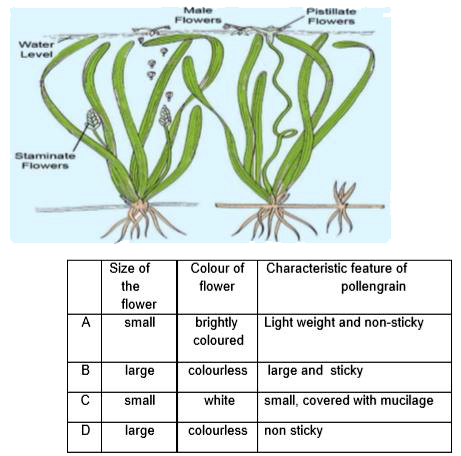From the following, identify the plants having inflorescences with male, female and sterile gall flowers
Casuarina
Helianthus
Ficus
Colacasia
The correct Answer is:C
To identify the plants having inflorescences with male, female, and sterile gall flowers, we will analyze each plant mentioned in the question based on the characteristics of their flowers.
1. Understanding Gall Flowers:
- Gall flowers are characterized by having short styles, which means that the stigma, style, and ovary are not well-developed. This makes these flowers dependent on external agents, such as insects (like wasps or bees), for pollination.
2. Analyzing Each Plant:
- Casuarina:
- This plant belongs to the Casuarinaceae family. It has long styles, which means it does not have gall flowers. Therefore, it does not have male, female, or sterile gall flowers.
- Helianthus:
- Helianthus, commonly known as sunflower, is part of the daisy family. It has a well-developed structure with many petals and reproductive organs. The styles are not short, so it does not produce gall flowers either.
- Ficus:
- Ficus, also known as the fig tree, has flowers with very short styles. This characteristic makes it reliant on wasps for pollination. Ficus produces male, female, and sterile gall flowers, as the structure of its flowers fits the definition of gall flowers.
- Colocasia:
- Colocasia, belonging to the Araceae family, has flowers with normal-length styles. Therefore, it does not produce gall flowers.
3. Conclusion:
- After analyzing all four plants, we find that only Ficus has inflorescences with male, female, and sterile gall flowers.
Final Answer:
The plant that has inflorescences with male, female, and sterile gall flowers is Ficus.
---
- Gall flowers are characterized by having short styles, which means that the stigma, style, and ovary are not well-developed. This makes these flowers dependent on external agents, such as insects (like wasps or bees), for pollination.
- Casuarina:
- This plant belongs to the Casuarinaceae family. It has long styles, which means it does not have gall flowers. Therefore, it does not have male, female, or sterile gall flowers.
- Helianthus:
- Helianthus, commonly known as sunflower, is part of the daisy family. It has a well-developed structure with many petals and reproductive organs. The styles are not short, so it does not produce gall flowers either.
- Ficus:
- Ficus, also known as the fig tree, has flowers with very short styles. This characteristic makes it reliant on wasps for pollination. Ficus produces male, female, and sterile gall flowers, as the structure of its flowers fits the definition of gall flowers.
- Colocasia:
- Colocasia, belonging to the Araceae family, has flowers with normal-length styles. Therefore, it does not produce gall flowers.
- After analyzing all four plants, we find that only Ficus has inflorescences with male, female, and sterile gall flowers.
The plant that has inflorescences with male, female, and sterile gall flowers is Ficus.
Similar Questions
Name one example for each of the following :
(i) A plant in which both male and female sex organs occurs in the same flower .
(ii) A plant in which separate male and female flowers are borne on the same individual at different positions.
(iii) A cultivated plant in which neither fruits nor seeds are formed.
(iv) A species in which the individual plant in either male of female.View SolutionIn the dioecious aquatic plant shown, identify the characteristics of the male flowers that reach the female flowers for pollination:
 View Solution
View Solution
Knowledge Check
- Question 1 - Select One
In cyathium inflorescence the ratio between male and female flowers is
Aone : manyBmany: oneCone:oneDmany : many - Question 2 - Select One
Consider the following statement (a-d) and select the option which includes all the correct ones :-
(a) Three type of flower is present in hypanthodium inflorescence, male female gall
(b) Male flower is present towards ostiole while female flower is present away from ostiole.
(c) Gall flower is fertile in nature.
(d) Male flower is present away from ostiole while female flower is present towards ostiole.AStatement a, bBStatement a, c, dCStatement c, dDStatement b, c, d - Question 3 - Select One
In which plant inflorescence receptacle becomes fleshy and hollow and bears flowers
Alaterally in basipetal orderBbasally in a clusterCterminally in a clusterDlaterally in acropetal succession
In which plant inflorescence receptacle becomes fleshy and hollow and bears flowers
View SolutionInflorescence of female flowers of Zea mays is
View SolutionRead the statement(s) given below and identify the incorrect statement (s)
I in cymose inflorescence main axis terminates in to a flower
II in racemose inflorescence main axis does not terminate in to a flower
III in racemose inflorescence flower are borne basipetally
IV in cymose inflorescence flowers are borne acropetally
Choose the correct optionView SolutionCorrect statement for Euphorbia?
(1) Leaves modified in to spines
(2)Stem modified into leaf like organ
(3)Cyathium inflorescence
(4) Ratio of male and female flowers is one : many respectivelyView SolutionIdentify from the following, a hormone produced by the pituitary gland in both males and femals but functional only in females.
View Solution

